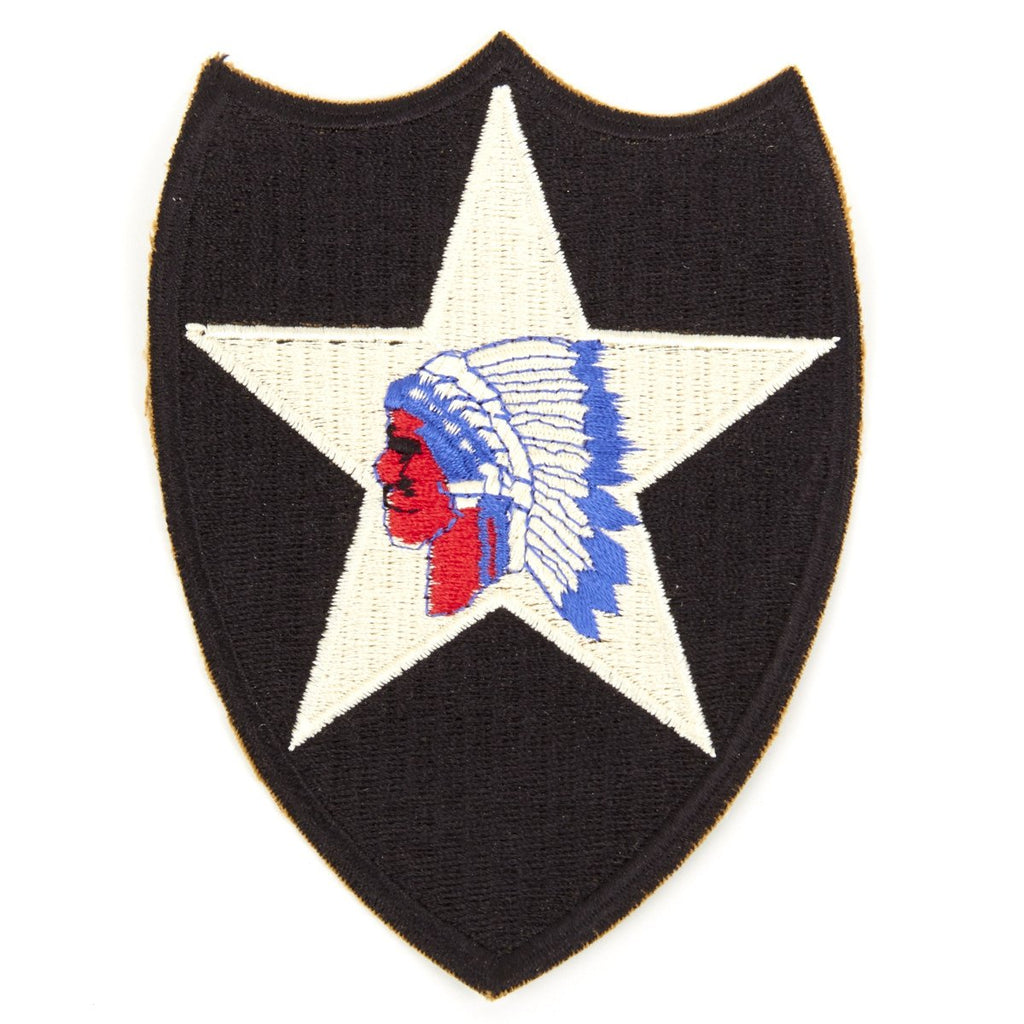-
New Made Item: Top quality embroidery. The 2nd Infantry Division ("Indianhead") ("2ID" or "2nd ID") is a formation of the United States Army.
Approximate dimensions:
4.5" H x 3" W
2nd Infantry Division in WWII:
After training in Northern Ireland and Wales from October 1943 to June 1944, the 2nd Infantry Division crossed the channel to land on Omaha Beach on D plus 2 (8 June 1944) near St. Laurent-sur-Mer. Attacking across the Aure River on 10 June, the division liberated Trévières and proceeded to assault and secure Hill 192, a key enemy strong point on the road to Saint-Lô. After three weeks of fortifying the position and by order of Commanding General Walter M. Robertson the order was given to take Hill 192. On 11 July under the command of Col.Ralph Wise Zwicker the 38th Infantry Regiment and with the 9th and the 23rd by his side the battle began at 5:45am. Using an artillery concept from World War I (rolling barrage) and with the support of 25,000 rounds of HE/WP that were fired by 8 artillery battalions, the hill was taken. Except for three days during the Battle of the Bulge, this was the heaviest expenditure of ammunition by the 38th Field Artillery Battalion; And was the only time during the 11 months of combat that 2nd Division Artillery used a rolling barrage. The division went on the defensive until 26 July. After exploiting the Saint-Lo breakout, the 2nd Division then advanced across the (Vire) to take (Tinhebray) on 15 August 1944. The division then raced toward (Brest/France), the heavily defended port fortress which happened to be a major port for German U-Boats. After 39 days of fighting the battle was won, and was the first place the Army Air Forces used bunker busting bombs.
The division took a brief rest 1926 September before moving to defensive positions at St. Vith, Belgium on 29 September 1944. The division entered Germany on 3 October 1944, and was ordered, on 11 December 1944, to attack and seize the Roer River dams. The German Ardennes offensive in mid-December forced the division to withdraw to defensive positions near Elsenborn Ridge, where the German drive was halted. In February 1945 the division attacked, recapturing lost ground, and seized Gemund, 4 March. Reaching the Rhine 9 March, the 2ID advanced south to take Breisig, 1011 March, and to guard the Remagen bridge, 1220 March.
The division crossed the Rhine on 21 March and advanced to Hadamar and Limburg an der Lahn, relieving elements of the 9th Armored Division, 28 March. Advancing rapidly in the wake of the 9th Armored, the 2nd Infantry Division crossed the Weser at Veckerhagen, 67 April, captured Göttingen 8 April, established a bridgehead across the Saale, 14 April, seizing Merseburg on 15 April. On 18 April the division took Leipzig, mopped up in the area, and outposted the Mulde River; elements which had crossed the river were withdrawn 24 April. Relieved on the Mulde, the 2nd moved 200 miles, 13 May, to positions along the German-Czech border near Schonsee and Waldmünchen, where 2 ID relieved the 97th and 99th ID's. The division crossed over to Czechoslovakia on 4 May 1945, and attacked in the general direction of Pilsen, attacking that city on VE Day. 2nd ID cooperated with Polish Holy Cross Mountains Brigade on these days. The division lost 3,031 killed in action, 12,785 wounded in action, and 457 died of wounds.
2nd Infantry Division returned to the New York Port of Embarkation on 20 July 1945, and arrived at Camp Swift at Bastrop, Texas on 22 July 1945. They started a training schedule to prepare them to participate in the scheduled invasion of Japan, but they were still at Camp Swift on VJ Day. They then moved to the staging area at Camp Stoneman at Pittsburg, California on 28 March 1946, but the move eastward was canceled, and they received orders to move to Fort Lewis at Tacoma, Washington. They arrived at Fort Lewis on 15 April 1946, which became their home station. From their Fort Lewis base, they conducted Arctic, air transportability, amphibious, and maneuver training.
- This product is available for international shipping.
- Eligible for all payments - Visa, Mastercard, Discover, AMEX, Paypal & Sezzle


We Buy Military Antiques
Our team expert buyers travels the world to pay fair prices for entire estate collections to singular items.
START SELLING TODAY





